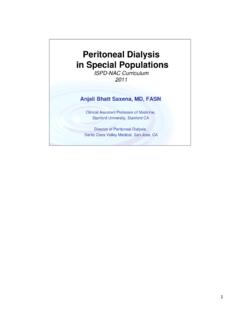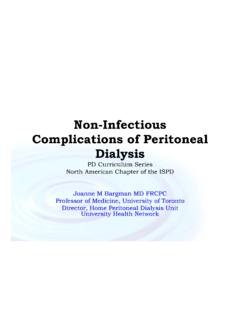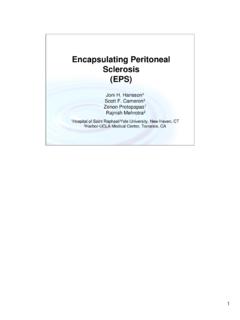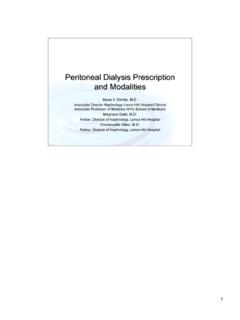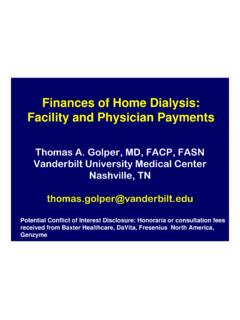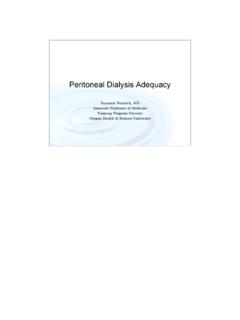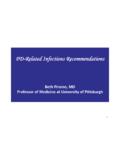Transcription of Anatomy and Physiology of Peritoneal Dialysis
1 Anatomy and Physiology of Peritoneal Dialysis Isaac teitelbaum , MDProfessor of MedicineDirector, Acute & Home Dialysis ProgramsUniversity of Colorado HospitalDenver, ColoradoOutline Peritoneal cavity as a Dialysis system Models of Peritoneal transport Physiology of Peritoneal transport Inverse relationship between solute transport and ultrafiltration Kinetics of Peritoneal transport Synthesis & Application Middle MoleculesAnatomy of The Peritoneum The lining of the abdominal cavity Two layers:parietal - lines the anterior wall and undersurface ofthe diaphragm - 20% of total SA; blood supply from abdominal wall visceral - covers the abdominal organs- 80% of total SA; blood supply from mesenteric aa and portal vv Gokal R, Textbook of PD, pp.
2 61-70 Anatomy of The Peritoneum Size 2 m2; approximates BSA Highly Vascular Semi-permeable/bi-directional Lymphatic drainage through diaphragmatic stomata Continuous with Fallopian Tubes in femalesGokal R, Textbook of PD, pp. 61-70 The Peritoneal Cavity as a Dialysis SystemTransport Processes in Peritoneal DialysisDiffusion-Movement of solute from an area ofhigherconcentrationto an area of of water from an area of higherconcentration (lower solute concentration)to an area of lowerconcentration(higher solute concentration)Models of Peritoneal Transport The three pore model The pore- matrix model The distributed modelTransport Across the Peritoneal Endothelium.
3 The Three Pore Model Large pores (100 - 200 )- few in number (3% of SA)- transport macromolecules- clefts between endothelial cells Small pores (40 - 60 )- most numerous (95% of SA)- allow transport of small solutes and water- postulated to be clefts in the endothelium; have not been demonstrated anatomically Ultrasmall (transcellular) pores (4 - 6 )- many in number (but only 2% of SA)- transport water only (Na sieving)-Demonstrated to be AQP 1 Transport Across the Peritoneal Endothelium:The Three Pore Model (cont d)Water Transport in Aquaporin- 1 Knockout MiceYang et al. AJP 276:C76, 1999110115120125130135140030609012015018 0210240 Dwell time (min)Sodium DHeimburger et al.
4 Kid Int 38: 495, 1990 Changes In Dialysate Sodium During Dwell (Sodium Sieving)Flessner M. Contrib Nephrol 163:7, 2009 Ultrafiltration in PD:The Pore-Matrix ModelUltrafiltration in PD:The Pore-Matrix Model The small and large pores represent different functional states of a single entity that depends on the density of the glycocalyx. The glycocalyx density is decreased by: Oxidized LDL Adenosine Ischemia reperfusion injury TNF Flessner M. Contrib Nephrol 163:7, 2009 Ultrafiltration in PD:The Distributed Model Increased effective Peritoneal surface area may occur:- During peritonitis- After prolonged exposure to high glucose-containing fluidsEffective Peritoneal Surface AreaTwo Clinical Endpointsfor Peritoneal Transport Solute Clearance diffusive convective Fluid RemovalFactors Influencing Solute Diffusion Surface Area Peritoneal Permeability Solute Characteristics Concentration Gradient Temperature of Dialysis Solution Blood Flow Dialysis Solution Volume in 24 hrs.
5 Dwell TimeUreaCreatinineMMDwell time (hours) to plasma (D/P) ratiosDiffusion Curves for Solutes of Varying SizeD/Px481216 Diffusion Kinetics From Blood to Dialysate Diffusive flux is highest in the first hour- the gradient is largest- and decreases over time By 4 hours, urea is > 90% equilibrated, creatinine > 60% equilibrated Further small solute removal is modest Long dwells more important for removal of middleMW solutes ( 2MG)Factors Influencing Ultrafiltration Surface area Peritoneal membrane permeability Pressure gradients - hydrostatic - oncotic- osmotic (really hydrostatic; 1 mOsm = 17 mm Hg)What Determines Transcapillary Ultrafiltration?
6 Flessner M. Kid Int 69:1494, 2006Jv= Lp S [Pplasma-Pif- j i,j ( i,plasma i,if)] Jvflow/areaLphydraulic conductivityStotal pore areaPplasmaintraluminal capillary hydrostatic pressure in plasmaPifinterstitial fluid hydrostatic pressure jFraction of the total pore area that is made up of the jthpore i,jReflection coefficient of the jth pore for the ithsolute i,plasmaOsmotic pressure in plasma due to the ith solute i,ifOsmotic pressure in the interstitium due to the ithsolutei,jOr, in UF rate (ml/min) = hydraulic conductivity (cm/min/mmHg) x total effective pore area (cm2) x[average osmotic pressure + net trans-membrane hydrostatic pressure - net oncotic pressure (mm Hg)]Factors Influencing Ultrafiltration Ideally we d like to use a solute with reflection coefficient (RC) ~ Glucose has a reflection coefficient of for AQP-1 but this accounts for only 2% of SA.
7 Despite having RC only ~ for the small pore, adding glucose to PD fluid creates an osmotic gradient and moves water from the blood into the Peritoneal cavity. Effect of Glucose AbsorptionTherefore, a major determinant of the average UF per exchange is the average glucose , as this will affect the rate of glucose absorption and the speed of decline of the glucose Permeability and Ultrafiltration slow transporters the tighter the Peritoneal membrane (higher mean glu)the slowerwill glucose diffuse out of the Peritoneal cavitythe osmotic gradient will be maintained longerthe moreultrafiltration will take placeMembrane Permeability and Ultrafiltration rapid transporters the leakier the Peritoneal membrane (lower mean glu)
8 The fasterwill glucose diffuse out of the Peritoneal cavitythe fasterthe osmotic gradient will dissipatethe lessultrafiltration will take placeThe Peritoneal Equilibration TestHow easily does solute (creatinine) cross from the blood to the Peritoneal cavity? Quantified as Dialysate creatinine concentrationPlasma creatinine concentrationorD/P creatinine (at t = 4 hours)The Peritoneal Equilibration TestHow long is glucose retained in the Peritoneal cavity? Quantified as:Dialysate concentration of glucose at t = 4hrsDialysate concentration of glucose at t = 0 hrorD/ D0glucose (at t = 4 hours) cannot use D/P glucose as a surrogate since glucose entering the plasma from dialysate is rapidly metabolizedPeritoneal Equilibration Test Protocol 2L of dextrose dialysate is infused with the patient supine after complete drain of a long (>8 hrs) 2 L dwell.
9 Blood and dialysate samples are taken immediately after infusion and at 2 and 4 hours for measurements of urea, creatinine, and glucose. Patient is drained upright after 4 hours and drain volume is recorded. Twardowski et al. PDB 7; 138, AveL. Peritoneal Equilibration Test ( Dextrose) VolumeLowL AveH AveHighTwardowski et al. PDB 7: 138, 1987 Standard Peritoneal Equilibration Test ( Dextrose)Modified Peritoneal Equilibration Test Similar to the standard PET except, Performed with dextrose, thereby creating a large osmotic gradient. Modified Peritoneal Equilibration Test Ultrafiltration failure is defined as net ultrafiltration < 400 cc at 4 hours Correlates well with clinical of D/P Urea Obtained by and PETP ride et al.
10 Perit Dial Int 22:365, hr2 of D/P Creatinine Obtained by and PETP ride et al. Perit Dial Int 22:365, of D/D0 Glucose Obtained by and PETP ride et al. Perit Dial Int 22:365, 2002 Discordance (> 1 Category) Between and PET at 4 HoursD/Purea3/47D/Pcreat1/47D/D0 glu0/45 Pride et al. Perit Dial Int 22:365, 2002 A PET using dextrose may be substituted for the standard PET. This allows for simultaneous evaluation of both the small solute transfer and ultrafiltration capacities of the Peritoneal membrane. However, commercially available programs for modeling Peritoneal adequacy have not been standardized to the PET. When Should the PET be Performed?

